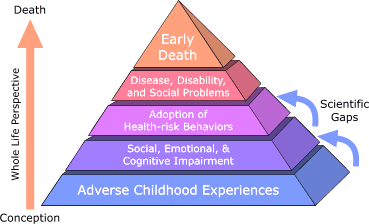 Only 55% of us had “secure attachment” as infants, according to research on 6,281 infant-parent pairs done during 1970-1999. [FN1, 2] This would worry us all if we knew what it meant, because the other 45% of us suffer “insecure attachment.” That means 45% of us have trouble with committed relationships.
Only 55% of us had “secure attachment” as infants, according to research on 6,281 infant-parent pairs done during 1970-1999. [FN1, 2] This would worry us all if we knew what it meant, because the other 45% of us suffer “insecure attachment.” That means 45% of us have trouble with committed relationships.
It’s worrisome because the attachment we had as kids continues all our lives in our relationships, say related studies of over 10,500 adults done during 1982-2009. [FN3] Plus, we pass our “insecurity” on to our own children.
These are the “quiet blockbuster” results of, first, Dr. Mary Ainsworth’s 1970-1978 “Strange Situation” study of babies, as extended by her assistant Dr. Mary Main. (Dr. Main & Dr. Daniel J. Siegel, above)
Second, Dr. Main discovered enough upset babies to become concerned about the parents. She created the Adult Attachment Interview (AAI) to study the adults in 1982. Her results, released 1984-96, showed 42-45% of adults were not securely attached, analogous to the infants above.
This 45% “insecure” figure starts to explain why we’ve got a 50% divorce rate, If (like me) you’ve tried dating after divorce, it won’t surprise you that science shows almost half the adults out there can’t manage a secure, committed, relationship. Ouch, you’ve experienced it.
And if 45% of us were “insecurely attached” in 1999, what’s the percent in 2017? In 1999 most of us hadn’t heard of the internet. In almost 20 years since, email, texting, and so on have further trashed our ability to relate in person. Several psychotherapists interviewed for this blog said that a round number of “about 50%” is a conservative estimate for how many Americans lack secure attachment today. Many believe it’s much higher.
Here’s more “about 50%” data. The 1998 Adverse Childhood Experiences (ACE) Study showed that 64-67% of 17,421 middle class subjects had one or more types of childhood trauma, and 38-42% had two or more types. In less privileged populations, these numbers are far higher. A national average of all economic groups would likely show 50% or more suffer ACE trauma.
The ACE Study lists physical and sexual abuse and 8 other types, including traumas that happen to newborns like physical and emotional neglect. Such trauma puts children into “fight-flight,” a chronic state proven to shut down the organism’s capacity for feelings of attachment and love. Think soldier in a battle, ramped up in “fight-flight”– he’s not into love. [FN4]
Half of us are in serious emotional health and medical trouble, and don’t even know it. Let’s get informed; then we can heal. If we didn’t get securely attached as kids, we can develop “earned secure attachment.” “It’s possible to change attachment patterns,” as Main’s colleagues Dr. Dan Siegel and Dr. Marion Solomon say. [FN5]
Strange Situation Experiment
 Attachment Theory isn’t new, it just gets too little air time. British psychiatrist John Bowlby (left) developed it in the 1950s while dealing with the post-WWII crisis of dislocated orphans. [FN6] Bowlby believed that all infants would seek to stay close to parents, since “proximity-seeking behavior” is best for survival. In 1952 he published a study of toddlers’ responses to separation from parents. It showed that “when toddlers were placed in unfamiliar surroundings that provided no stable caregivers, they underwent three… stages of response to separation: protest, despair, and finally detachment,” writes Mary Main. [FN7]
Attachment Theory isn’t new, it just gets too little air time. British psychiatrist John Bowlby (left) developed it in the 1950s while dealing with the post-WWII crisis of dislocated orphans. [FN6] Bowlby believed that all infants would seek to stay close to parents, since “proximity-seeking behavior” is best for survival. In 1952 he published a study of toddlers’ responses to separation from parents. It showed that “when toddlers were placed in unfamiliar surroundings that provided no stable caregivers, they underwent three… stages of response to separation: protest, despair, and finally detachment,” writes Mary Main. [FN7]
 Dr. Mary Ainsworth studied with Bowlby in London 1950-54, then studied this same “proximity-seeking behavior” (attachment) in infant-mother pairs in homes in Kampala, Uganda, published as “Infancy in Uganda” (1967). Next, she “found astonishing similarities” in Baltimore, MD pairs. [FN7]
Dr. Mary Ainsworth studied with Bowlby in London 1950-54, then studied this same “proximity-seeking behavior” (attachment) in infant-mother pairs in homes in Kampala, Uganda, published as “Infancy in Uganda” (1967). Next, she “found astonishing similarities” in Baltimore, MD pairs. [FN7]
So Ainsworth created the Strange Situation in the early 1970s, as a science experiment at Johns Hopkins in Baltimore to document this infant behavior. “Ainsworth deliberately structured the Strange Situation to include three of Bowlby’s ‘natural clues to danger’… to arouse babies to seek proximity” to the parent, Main says. Researchers watch and video-tape through one-way glass, as infant-mother pairs react to apparent danger. First the babies respond to the strange lab room; then to two entrances of a stranger; then separation from mother at two different times. [FN8]
All or most babies were expected to stay close to parents as Bowlby thought. Such babies “that Ainsworth termed ‘secure,’ play and explore happily prior to separation; show signs of missing the parent during separation, such as crying and calling; seek proximity immediately upon the parent’s return; and then return to play and exploration, ‘secure’ once again in the parent’s presence,” said Main. [FN8]
But 30% of babies did not act secure — they avoided mom. Given a choice, they show no preference between mom and the stranger. “While a majority of infants behaved as expected and were termed secure, to Ainsworth’s amazement six showed little or no distress at being left alone in the unfamiliar environment, and then avoided and ignored the mother upon her return.” [FN7]
Ainsworth decided to categorize these babies separately, as “avoidant” of mother, so now she had two types: (A) Insecure Avoidant, and (B) Secure. She concluded that their mom didn’t respond to them, or respond with enough sensitivity to understand their actual need, so the infants felt “insecure.” [FN8]
Still later Ainsworth saw that of the insecure babies, some had yet a third reaction: actually, they were “ambivalent” about mom. They were very distressed when mom left, but on her return, they alternated between avoiding and frantic clinging–plus, they never calmed down. Research showed that ambivalent attachment results from moms who are sometimes available, sometimes not, so babies learn they can’t depend on mom to be there when they need her.
Thus it was that “surprisingly, Ainsworth found that infant responses to separation and reunion fell into three distinct, coherently organized patterns of attachment,” and added a third category: (C) Insecure Ambivalent, Main reports. [FN8-9]
By 1978, Ainsworth’s estimate for U.S. babies was (B) Securely attached 69%; (A) Avoidant 23%, (C) Ambivalent 8%.
By 1988, her Strange Situation study had been done with 2,000 infant-parent pairs in 32 studies in 8 countries. By 1999 it had been done globally with 6,282 infant-parent pairs. Some countries varied, but the worldwide results averaged out the same as Ainsworth’s 1970s studies. Amazing, but it makes sense considering the U.S. is a global melting pot. [FN1, 9, 11]
But stay tuned for my next blog Feb. 6, when Ainsworth’s grad student Mary Main gets into the act big time. Main found that Ainsworth’s concept of Securely Attached had flaws that made necessary a whole new fourth category of attachment failure. And a whole lot fewer than 69% turned out to be “secure.”
If you can’t wait for Part 2 on Feb. 6, the whole article is here: http://attachmentdisorderhealing.com/adult-attachment-interview-aai-mary-main/
———————————
Kathy’s news blogs expand on her book “DON’T TRY THIS AT HOME: The Silent Epidemic of Attachment Disorder—How I accidentally regressed myself back to infancy and healed it all.” Watch for the continuing series each Friday, as she explores her journey of recovery by learning the hard way about Attachment Disorder in adults, adult Attachment Theory, and the Adult Attachment Interview.
Footnotes
FN1 NIH: Benoit, Diane , MD, FRCPC, “Infant-parent attachment: Definition, types, antecedents, measurement and outcome,” Paediatr Child Health, Oct 2004; 9(8) p. 541–545 at: www.ncbi.nlm.nih.gov/pmc/articles/PMC2724160/ 4th subhead “Measurement” reports:
“The three ‘organized’ strategies (secure, avoidant and resistant) are assessed in the Strange Situation (SS), a 20-minute laboratory procedure where patterns of infant behaviour toward the caregiver following two brief separations are categorized… “Infants with secure attachment greet and/or approach the caregiver and may maintain contact but are able to return to play, which occurs in 55% of the general population… Infants with insecure-avoidant attachment fail to greet and/or approach, appear oblivious to their caregiver’s return… avoiding the caregiver, which occurs in 23% of the general population. Infants with insecure-resistant [ambivalent] attachment are extremely distressed by separations and cannot be soothed at reunions, displaying much distress and angry resistance to interactions with the caregiver, which occurs in 8% of the general population.” [This NIH article earlier reports that the remaining “approximately 15% suffer insecure ‘disorganized’ attachment,” citing their own footnote which states “In normal, middle class families, about 15% of infants develop disorganized attachment.” [23%+8%+15% = 46% not securely attached.]
FN2 Felitti VJ, Anda RF, et. al, 1998, “Relationship of childhood abuse and household dysfunction to many of the leading causes of death in adults: The Adverse Childhood Experiences (ACE) Study,” American Journal of Preventive Medicine 1998;14:245–258. Detailed article on the ACE Study: http://acestoohigh.com/2012/10/03/the-adverse-childhood-experiences-study-the-largest-most-important-public-health-study-you-never-heard-of-began-in-an-obesity-clinic/
FN3 Karr-Morse, Robin, Wiley, Meredith, “Scared Sick,” Penguin Basic Books, 2012
FN4 Porges, Stephen, PhD, “Body, Brain, Behavior: How Polyvagal Theory Expands Our Healing Paradigm,” 2013, http://stephenporges.com/images/NICABM%202013.pdf
–“Beyond the Brain: Vagal System Holds the Secret to Treating Trauma,” 2013, http://stephenporges.com/images/nicabm2.pdf
–“The Polyvagal Theory for Treating Trauma,” 2011, http://stephenporges.com/images/stephen%20porges%20interview%20nicabm.pdf
–“Polyvagal theory: phylogenetic substrates of a social nervous system,” International Journal of Psycho-physiology 42, 2001, Dept. of Psychiatry, Univ. Illinois Chicago, www.wisebrain.org/Polyvagal_Theory.pdf
FN5 Earned secure attachment occurs when we experience harmful parenting, so we start with insecure attachment, but find ways to “rise above” childhood trauma and “are now securely attached… What’s more important than what happened to us, is how we’ve made sense of our own childhood,” Dr. Dan Siegel says. “When we make sense of our past… we become free to construct a new future for ourselves and for how we parent our children. Research is clear: If we make sense of our lives, we free ourselves from the prison of the past.” (Source: video by Dr. Mary Main, Dr. Erik Hesse, Dr. Daniel J. Siegel, Dr. Marion Solomon: https://www.youtube.com/watch?v=YJTGbVc7EJY )
The question is: what ways? How do we “rise above” and “make sense” of our childhood trauma?
“Mindfulness has been shown to be effective in healing insecure attachment,” say Siegel’s recent writings. “The purpose of both psychotherapy and mindfulness practice is to provide this internalized secure base. Attunement, whether it is internal in mindfulness, or interpersonal in attachment, is what leads to a sense of secure base.” (The Mindful Therapist: A Clinician’s Guide to Mindsight and Neural Integration, W.W. Norton, 2010; Mindsight: The New Science of Personal Transformation, Random House, 2010).
“The regular exercise of mindful awareness seems to promote the same benefits–bodily and affective self-regulation, attuned communication with others, insight, empathy, and the like–that research has found to be associated with childhood histories of secure attachment,” Siegel wrote earlier. “ Mindfulness and secure attachment alike are capable of generating… the same invaluable psychological resource: an internalized secure base.” (Siegel, 2007, Wallin, 2007, p. 5-6).
In his 1999 book “The Developing Mind: How Relationships and the Brain interact to shape who we are,” (Guilford Press), Siegel defined “earned secure/autonomous attachment” as a pattern noticed by therapists doing the Adult Attachment Interview: “individuals whose experiences of childhood… [were] likely to produce insecure attachment (avoidant, ambivalent, or disorganized),” but their AAI interview responses instead show “a fluidity in their narratives and a flexibility in their reflective capacity, such that their present state of mind with respect to attachment is rated as secure/autonomous. These individuals often appear… to have had a significant emotional relationship with a close friend, romantic partner, or therapist, which allowed them to develop out of insecure…into a secure/autonomous AAI status.”
FN6 Bowlby, John, “The Nature of a Child’s Tie to His Mother,” British Psychoanalytical Society, London, 1958; “Attachment and Loss,” New York, Basic Books, 1969
FN7 Main, Mary, 2000, “The Adult Attachment Interview: Fear, attention, safety and discourse processes;” also titled “The Organized Categories of Infant, Child, and Adult Attachment: Flexible vs. Inflexible Attention Under Attachment-Related Stress,” Jour of Amer Psychoanalytic Assoc, 48:1055-1095; 2000. *p.1091: “The same average parent-to-child, secure/insecure match of 75% holds even when the interview is conducted before birth of the first child…” Lifespanlearn.org/documents/Main.pdf
FN8 Main, Mary, 2005, with Hesse, Erik & Kaplan, Nancy, “Predictability of Attachment Behavior and Representational Processes at 1, 6, and 19 Years of Age – The Berkeley Longitudinal Study,” Chapter 10 of “Attachment from Infancy to Adulthood: The Major Longitudinal Studies,” edited by Klaus E. Grossmann, Karin Grossmann, and Everett Waters, pp. 245–304, New York: Guilford Press. Main refers to it as “Regensburg.”
https://lifespanlearn.org/documents/5.Main Regensburg 2005 .pdf
–Main’s summary of the Strange Situation in this document:
“Ainsworth structured the Strange Situation procedure to include three of Bowlby’s ‘natural clues to danger’ in eight episodes: 1. Introduction to the room. 2. Mother and infant are left alone in a toy-filled environment whose unfamiliarity supplies the first natural clue to danger. However, the mother’s presence is expected to provide the infant with security sufficient for exploration and/or play. 3. Providing a second clue to danger, a stranger joins the mother and infant. 4. The mother leaves the infant with the stranger, providing two combined clues to increased danger. 5. The mother returns, and the stranger departs…. Many infants initially seek proximity but then, reassured of their mothers’ nearness, resume play. 6. The mother leaves, and the infant remains entirely alone in the unfamiliar setting. Infant distress can be strong at this point, and this episode is often terminated rapidly. 7. The stranger, rather than the mother, enters the room. 8. The mother returns… By now, most infants are expected to be crying, and actively not only seeking proximity to mothers, but also… indicating a strong desire to be held… Nonetheless, they are expected to settle and renew interest in exploration and play by the end of this 3-minute period…
“Somewhat surprisingly, Ainsworth found that infant responses to separation and reunion in this procedure fell into three distinct, coherently organized patterns of attachment (“secure,” “insecure-avoidant,” and “insecure-ambivalent” (Ainsworth, Blehar, Waters, & Wall, 1978). … Given the length and complexity of this chapter, we suggest individuals divide reading to its three central parts (secure attachment, pp. 261–273; avoidant attachment, pp. 273–279; and disorganized attachment pp. 279–288).”
FN9 (1988 van Ijzendoorn: on global proof of Ainsworth’s 3 categories; written before Main’s 4 category put in use)
van IJzendoorn, Marinus H.; Kroonenberg, Pieter M. “Cross-Cultural Patterns of Attachment: A Meta-Analysis of the Strange Situation,” Child Development,Vol 59 No 1, Feb 1988, p.147–56. Abstract: http://www.jstor.org/discover/10.2307/1130396?uid=3739560&uid=2&uid=4&uid=3739256&sid=21103831443011
17,312 total views, 3 views today



Pingback: ATTATCHMENT – thinkingfeelingbeing.com
Pingback: HOW DO PAST RELATIONSHIPS AFFECT CURRENT PERCEPTIONS – thinking-feeling-being
Pingback: Name Memories Without Words – Sundown Healing Arts